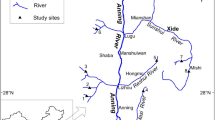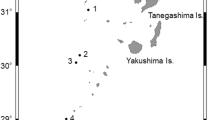Summary
The feeding strategies and feeding techniques of 12 nematode species, isolated from the Ems-Dollard estuary, were investigated in agar cultures. In the consumption of bacteria, algae, diatoms, protozoa and small metazoa, two main strategies are distinghuished: the non-selective strategy, characteristic of species living on the surface of macrophytes, and the selective strategy, characteristic of sediment-inhabiting species. The selective strategists showed various ingestion techniques, depending on the size and armature of the buccal cavity; food items could be ingested whole, or pierced or cracked and the contents sucked out.
Similar content being viewed by others
References
ADMIRAAL, W., LA. BOUWMAN., L. HOEKSTRA and K. ROMEYN, 1983. Qualitative and quantitative interactions between microphytobenthos and herbivorous meiofauna on a brackish intertidal mud-flat. Int. Revue ges. Hydrobiol., 68: 175–191.
BOUWMAN, L.A., 1981: A survey of nematodes from the Ems estuary. Part I: Systematics. Zool. Jb. Syst. 108: 335–385.
BOUWMAN, L.A., 1983. A survey of nematodes from the Ems estuary. Part II: Species assemblages and associations. Zool. Jb. Syst., 110: 345–376.
JENSEN, P., 1982. Diatom-feeding behaviour of the free-living marine nematodeChromadorita tenuis. Nematologica, 28: 71–76.
LOPEZ, G., F. RIEMANN and M. SCHRAGE, 1979. Feeding biology of the brackish-water oncholaimid nematodeAdoncholaimus thalassophygas. Mar. Biol., 54: 311–318.
MAERTENS, D.., 1975. Observations on the lifecycle ofPrionchulus punctatus (COBB 1917) (Nematoda) and some culture conditions. Biol. Jb. Dodonæa, 43: 197–218.
ROMEYN, K., L.A. BOUWMAN and W. ADMIRAAL, 1983. Ecology and cultivation of the herbivorous brackish-water nematodeEudiplogaster pararmatus (Rhabditida, W. SCHNEIDER 1938). Mar. Ecol. Prog. Ser., 12: 145–153.
WARWICK, R.M., 1981. Survival strategies of meiofauna. In: N.V. JONES and W.J. WOLFF, (eds.). Feeding and survival strategy of estuarine organisms. Mar. Sci., 1: 39–48.
WIESER, W., 1953. Die Beziehung zwischen Mundhöhlengestalt, Ernährungsweise und Vorkommen bei marinen Nematoden. Ark. Zool. 4: 439–484.
Author information
Authors and Affiliations
Additional information
Publication No. A 73 of the project ‘Biological Research in the Ems-Dollard estuary’.
Rights and permissions
About this article
Cite this article
Romeyn, K., Bouwman, L.A. Food selection and consumption by estuarine nematodes. Hydrobiological Bulletin 17, 103–109 (1983). https://doi.org/10.1007/BF02280819
Issue Date:
DOI: https://doi.org/10.1007/BF02280819




